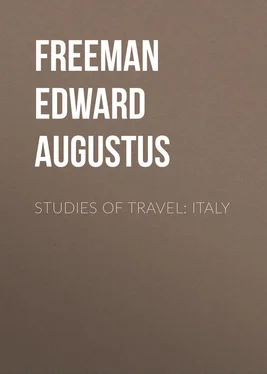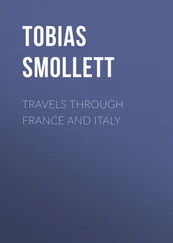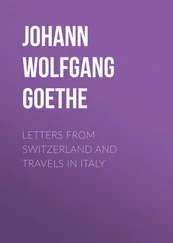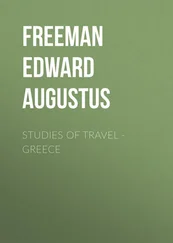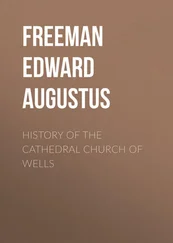Edward Freeman - Studies of Travel - Italy
Здесь есть возможность читать онлайн «Edward Freeman - Studies of Travel - Italy» — ознакомительный отрывок электронной книги совершенно бесплатно, а после прочтения отрывка купить полную версию. В некоторых случаях можно слушать аудио, скачать через торрент в формате fb2 и присутствует краткое содержание. Жанр: foreign_antique, foreign_prose, на английском языке. Описание произведения, (предисловие) а так же отзывы посетителей доступны на портале библиотеки ЛибКат.
- Название:Studies of Travel: Italy
- Автор:
- Жанр:
- Год:неизвестен
- ISBN:нет данных
- Рейтинг книги:5 / 5. Голосов: 1
-
Избранное:Добавить в избранное
- Отзывы:
-
Ваша оценка:
- 100
- 1
- 2
- 3
- 4
- 5
Studies of Travel: Italy: краткое содержание, описание и аннотация
Предлагаем к чтению аннотацию, описание, краткое содержание или предисловие (зависит от того, что написал сам автор книги «Studies of Travel: Italy»). Если вы не нашли необходимую информацию о книге — напишите в комментариях, мы постараемся отыскать её.
Studies of Travel: Italy — читать онлайн ознакомительный отрывок
Ниже представлен текст книги, разбитый по страницам. Система сохранения места последней прочитанной страницы, позволяет с удобством читать онлайн бесплатно книгу «Studies of Travel: Italy», без необходимости каждый раз заново искать на чём Вы остановились. Поставьте закладку, и сможете в любой момент перейти на страницу, на которой закончили чтение.
Интервал:
Закладка:
Perugia, we need hardly say, is a city of paintings, and it is as receptacles for paintings that its churches seem mainly to be looked on. But some of them deserve no small attention on other grounds. At the two ends of the city are two churches which follow naturally on the Etruscan and Roman walls and gates. At one end, the Church of St. Angelo, circular within, sixteen-sided without, forms one of the long series of round and polygonal churches which stretch from Jerusalem to Ludlow. And this, clearly a building of Christian Roman times, with its beautiful marble and granite Corinthian columns, though not one of the greatest in size, holds no mean place among them. At the other end, the Abbey of Saint Peter, amid many changes, still keeps two noble ranges of Ionic columns, the spoils doubtless of some Pagan building at its first erection in the eleventh century. Nor must the duomo itself be judged of by its outside. The work of a German architect, it shows a German character in the three bodies of the same height, and its pillars consequently of amazing height. But at Perugia it is not churches or palaces or earlier remains which we study, each apart from other things. Here they all unite to form a whole greater than any one class alone – Augusta Perusia itself.
The Volumnian Tomb
The ancient Etruscans have some points of analogy with the modern Freemasons. This last familiar and yet mysterious body seems to let the outer world know everything about itself, except what it is. We have read various books by Freemasons about Freemasonry, about its history, its constitution, its ritual. On all these points they seem to give us the fullest particulars: we have only to complain that the historical part is a little vague, and its evidence a little uncertain. We should not like rashly to decide whether Freemasonry was already ancient in the days of Solomon or whether it cannot be traced with certainty any further back than the eighteenth century. But we know the exact duties of a Tyler, and we know that at the end of a Masonic prayer we should answer, not "Amen," but "So mote it be." Still, what Freemasonry is, how a man becomes a Freemason, or what really distinguishes a Freemason from other people, are points about which the Masonic books leave us wholly in the dark. So it is with the Etruscans. We seem to know everything about them, except who they were. As far as we can know a people from their arts and monuments, there is no people whom we seem to know better. We have full and clear monumental evidence as to the people themselves, as to many points in their ways, thoughts, and belief. We know how they built, carved, and painted, and their buildings, sculptures, and paintings, tell us in many points how they lived, and what was their faith and worship. We have indeed no Etruscan books; but their language still lives, at least it abides, in endless inscriptions. But who the Etruscans were, and what their language was, remain unsolved puzzles. The ordinary scholar is half-amused, half-provoked, at long lines of alphabetic writing, of which, as far as the mere letters go, he can read a great deal, but of which, save here and there a proper name, he cannot understand a word. He knows that one ingenious man has read it all into good German and another into good Turkish. He curses every Lucumo whose image he sees for sticking like a Frenchman to his own tongue. Why could they not write up everything in three or four languages? How happy he would be if he could light on a Latin or Greek crib which would give life to the dead letter. For surely nothing in the world so truly answers the description of a dead letter, as words after words, most of which it is not hard to spell, but at the meaning of which we cannot even guess.
It is natural that in the museums of the Etruscan cities the monuments of a kind whose interest is specially local should form a chief part of the show. At Florence, at Arezzo, at Cortona, at Perugia, the collections which each city has brought together make us familiar, if we are not so already, with much of Etruscan art and Etruscan life. Or shall we say that what they really make us familiar with is more truly Etruscan death? Our knowledge of most nations of remote times comes largely from their tombs and from the contents of their tombs, and this must specially be the case with a people who, like the Etruscans, have left no literature behind them. The last distinction makes it hardly fair to attempt any comparison between the Etruscans and nations like the Greeks or the Romans, with whose writings we are familiar. But suppose we had no Greek or Roman literature, suppose we had, as we have in the case of the Etruscans, no means of learning anything of Greek or Roman life, except from Greek and Roman monuments. The sepulchral element would be very important; but it would hardly be so distinctly dominant as it is in the Etruscan case. At all events, it would not be so distinctly forced upon the thoughts as it is in the Etruscan case. Take a Roman sarcophagus: we know it to be sepulchral, but it does not of itself proclaim its use; there often is no distinct reference to the deceased person; at all events, his whole figure is not graven on the top of the chest which contains his bones or his ashes. But in the Etruscan museums it is the sepulchral figures which draw the eye and the thoughts towards them far more than anything else, more than even the chimæra, the bronze lamp, and the painted muse. Of various sizes, of various degrees of art, they all keep one general likeness. The departed Lucumo leans on his elbow, his hand holding what the uninitiated are tempted to take for a dish symbolizing his admittance to divine banquets in the other world, but which the learned tell us is designed to catch the tears of those who mourn for him. Sometimes the Lucumonissa – if we may coin so mediæval a form – lies apart, sometimes along with her husband. On the whole, these Etruscan sculptures seem to bring us personally nearer to the men of a distant age and a mysterious race than is done by anything in either Greek or Roman art.
But if these works can teach us thus much when set in rows in a place where they were never meant to be set up, how much more plainly do they speak to us when we see them at home, untouched, in the place and in the state in which the first artist set them! The Volumnian tomb near Perugia is one of the sights which, when once seen, is not likely to be forgotten. The caution does not bear on Etruscan art; but it is well to walk to it from St. Peter's Abbey; going by the railway is a roundabout business, and the walk downwards commands a glorious and ever-shifting view over the plain and the mountains, with the towns of Assisi, Spello, and a third further on – can it be distant Trevi? Foligno lies down in the plain – each seated on its hill. The tomb is reached; a small collection from other places has been formed on each side of the door. This is all very well; but we doubt the wisdom of putting, as we understood had been done, some things from other places in the tomb itself. But this is not a moment at which we are inclined to find fault. We rejoice at finding that what ought to be there is so happily and wisely left in its place, and are not greatly disturbed if a few things are put inside which had better have been left outside. The stone doorway of the lintelled entrance – moved doubtless only when another member of the house was literally gathered to his fathers – stands by the side; it was too cumbrous to be kept in its old place now that the tomb stands ready to be entered by all whose tastes lead them that way. We go in; the mind goes back to ruder sepulchres at Uleybury and New Grange, of sepulchres at least as highly finished in their own way at Mykênê. But those were built, piled up of stones; here the dwelling of the dead Lucumos is hewn in the native tufa. The top is not, as we might have looked for, domical; it imitates the forms of a wooden roof. From it still hang the lamps; on its surface are carved the heads of the sun-god and of the ever-recurring Medusa. Nor is the sun-god's own presence utterly shut out from the home of the dead. It is a strange feeling when a burst of sunshine through the open door kindles the eyes of the Gorgon with a strange brilliancy, and lights up the innermost recess, almost as when the sinking rays light up the apses of Rheims and of St. Mark's. In that innermost recess, fronting us as we enter, lies on his kistwaen – may we transfer the barbarian name to so delicate a work of art? – the father of the household gathered around him. He is doubtless very far from being the first Felimna , but the first Felimna whose ashes rest here. The name of the family can be spelled out easily by those who, without boasting any special Etruscan lore, are used to the oldest Greek writing from right to left. Children and grandchildren are grouped around the patriarch; and here comes what, from a strictly historical view, is the most speaking thing in the whole tomb. The name of Avle Felimna can be easily read on a chest on the right hand. On the left hand opposite to it is another chest which has forsaken the Etruscan type. Here is no figure, no legend in mysterious characters. We have instead one of those sepulchral chests which imitate the figure of a house with doors. The legend, in every-day Latin, announces that the ashes within it are those of P. Volumnius A. F. That is, the Etruscan Avle Felimna was the father of the Roman Publius Volumnius. We are in the first century before our æra, when the old Etruscan life ended after the Social War, and when the Lucumos of Arretium and Perusia became Roman Clinii and Volumnii. To an English scholar the change comes home with a special force. He has an analogy in the change of nomenclature in his own land under Norman influences in the twelfth century. Publius Volumnius, son of Avle Felimna, is the exact parallel to Robert the son of Godwin, and a crowd of others in his days, Norman-named sons of English fathers.
Читать дальшеИнтервал:
Закладка:
Похожие книги на «Studies of Travel: Italy»
Представляем Вашему вниманию похожие книги на «Studies of Travel: Italy» списком для выбора. Мы отобрали схожую по названию и смыслу литературу в надежде предоставить читателям больше вариантов отыскать новые, интересные, ещё непрочитанные произведения.
Обсуждение, отзывы о книге «Studies of Travel: Italy» и просто собственные мнения читателей. Оставьте ваши комментарии, напишите, что Вы думаете о произведении, его смысле или главных героях. Укажите что конкретно понравилось, а что нет, и почему Вы так считаете.
